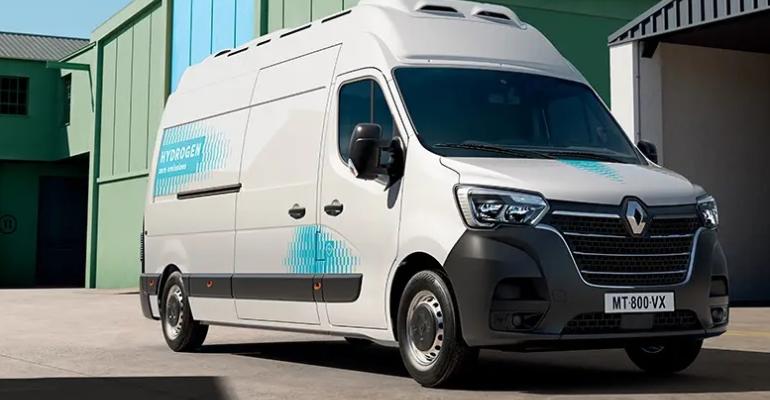Renault’s joint venture exploring commercially viable hydrogen fuel-cell light commercial vehicle powertrains, Hyvia, admits its products are currently three times more expensive than traditional internal-combustion alternatives.
However, CEO Nicolas Champetier tells delegates to the 2024 Hyvolution hydrogen-focused conference in Paris that its main mission is to rapidly scale up fuel-cell production to the point it starts to enjoy the economies of scale that bring it in line with those of battery-electric-vehicle powertrains.
To this end the company, set up in 2021 as a joint venture between Renault and energy specialist Plug, has created a gigafactory in Flins, France, expecting to reach an output of 1,000 this year. By 2030 that output should be achieving production many times more units annually.
Champetier says: “The Renault Master H2-Tech is our first offering starting from 2023, more or less covering all the potential use cases. It has long range and fast refueling. (In) April 2024 the New Master will be on offer with both ICE and BEV versions.
“We are on the first step of our gigafactory and we have the potential of producing 1,000 units per year. In Flins we are producing the fuel-cell systems that will be assembled later at the Batilly plant, the production plant for the Master.
“We need price competitiveness with BEVs by 2030. Today we can’t do this but it’s a new technology so that is understandable. At the moment, we are about three times more expensive than BEVs, so that’s why we need the subsidies.”
To this end the company is now teamed up with transport authorities in the Auvergne-Rhône-Alpes Region and fueling infrastructure specialist HYmpulsion to accelerate the deployment of hydrogen mobility in the region. The authorities have set up substantial subsidies to support the acquisition of hydrogen-powered light commercial vehicles.
HYmpulsion is deploying a network of more than 15 hydrogen filling stations in the region and is supporting Hyvia in providing support for business customers. About 50 vehicles are due to be delivered in the region by the end of 2024.
Champetier does not see hydrogen fuel cells competing in the same space as BEVs, which are best suited to very high mileage applications in a short space of time where a fleet is able to employ a high churn rate of its vehicles. Fuel-cell powertrains are more suitable for the fleet that have moderate annual mileage but offer a much longer lifecycle than a BEV with the added advantage of fast refueling times.
He concludes: “In 2030 we expect to have 30% of market share which means tens of thousands of units. Until we get to scale we require subsidies such as La Région Auvergne-Rhône-Alpes to make it affordable for clients.
“In the long term we think hydrogen is the right solution for zero-emission transport in Europe. Of course, we need to be able to make huge qualities of green hydrogen to be able to supply affordable fuel to our customers and this is what we will be working on.”





